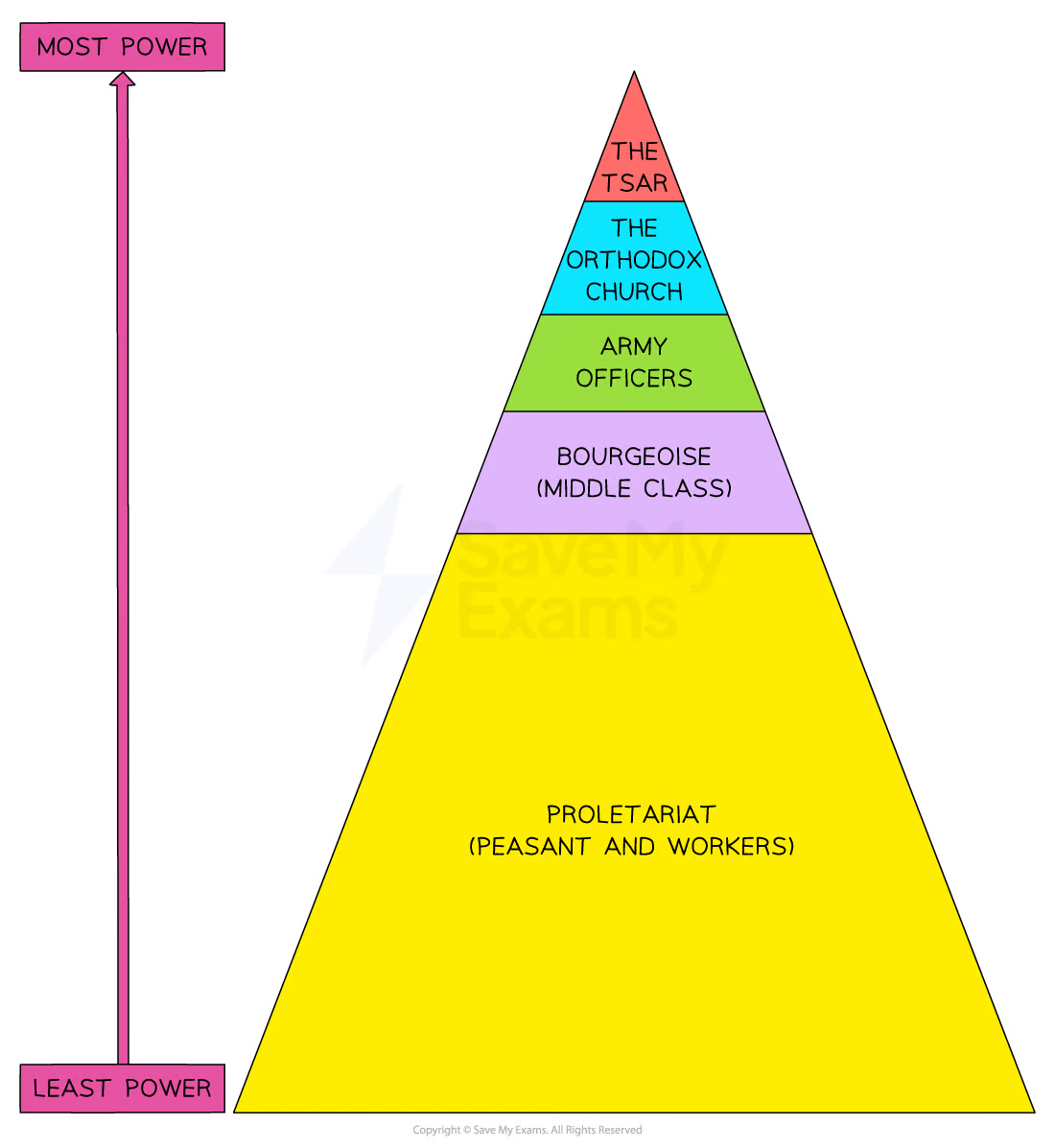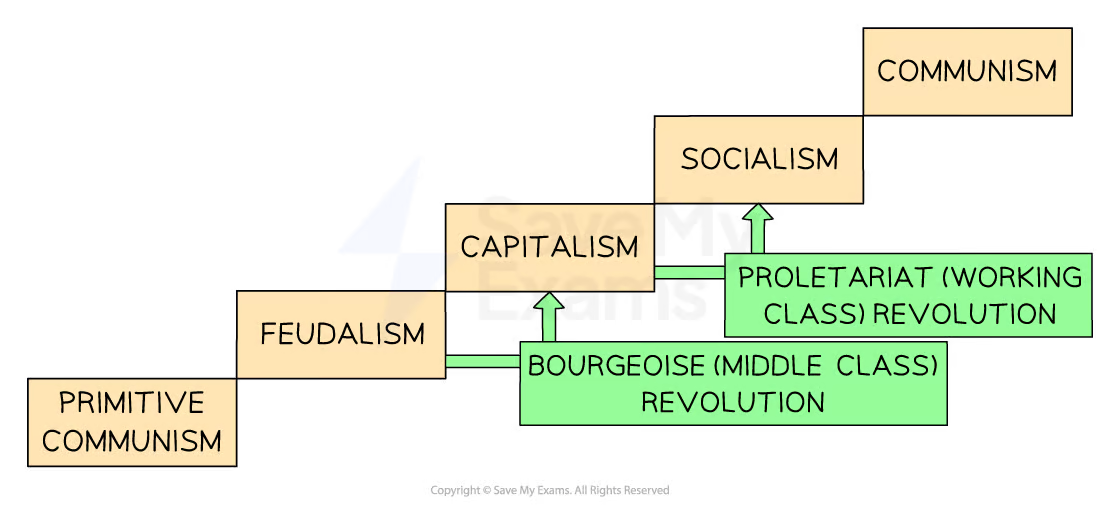russia background (-1914)
1/25
There's no tags or description
Looks like no tags are added yet.
Name | Mastery | Learn | Test | Matching | Spaced |
|---|
No study sessions yet.
26 Terms
how was the size of russia a problem for the tsar
size of country: the empire was 5,000km wide, with the ural mountains dividing the empire
this meant it was difficult to get transport across to west russia from east of the murals (where most of russia’s industry and population lived and tsar nicholas lived in st petersburg)
it was also difficult for the tsar to communicate new policies and speak generally with his subjects in rural territories across the mountains (the capital was in st petersburg)
how was the access to land for cultivation problem for the tsar
climate: russia included many extreme terrains which couldn’t be accessed at all, including:
a flat, treeless grassland plain in the centre whose poor quality supported little vegetation for agriculture
a forest belt in the east whose timber, furs, and minerals were impossible to cultivate and use for economic benefit
this made it difficult for the tsar to cultivate any land at all to feed his subjects
how was climate a problem for the tsar
farming was made difficult by the combination of low rainfall and extreme variations in temperature, including:
an infertile, economically futile desert in the south that saw temperatures of over 45c in the summer
arctic tundra in the north: in 1900, the town verkhoyansk in the north was the coldest place on earth so the terrain was useless due to the dead vegetation and infertile soil
this meant sowing and harvesting had to be carried out quickly: only 10% of russian land was suitable for farming
this meant it was difficult for the tsar to incentivise farming for peasants and it meant he had to rely on unreliable importation of food
how were defence and transportation a problem for the tsar
russia bordered 9 other countries and had no natural barriers for attack from the west
seaports froze in the winter and land routes were blocked by snow drift for half of the year
this meant the tsar was unable to develop trading routes to sustain the growth of more towns
in 1900, only 13% of the population were urbanised and rural-urban migration was slower than average: this meant the tsar had little positive economic output
how was ethnic distribution a problem for the tsar
issues stemming from cultural diversity
the tsar’s legal enforcement was challenged by protesting minorities: many nationalities (e.g poles) wanted the right to self-determination and autonomy and protested for it, resisting law enforcement
only 40% of the population was ethnically russian (ukranians: 22.4%; poles: 7.9%; jews 5%)
communication was challenging:
having over 150 languages and 1 national language led to other cultures feeling dominated, leading to more riots
russification: policy of enforcing Russian culture on the vast numbers of ethnic minorities that lived in the Russian Empire
greatly affected poles lithuanians and ukranians
all people had to speak one language
minorities felt dominated
how did social structure cause a problem for the tsar
peasants:
80% population
poorly educated: many lived in subsistence with reduced earning potential and shorter life expectancy
industrial workers:
less than 5% population
lived in terrible conditions
lived in houses with poor sanitation: diseases like cholera spread rapidly, leading to reduced life expectancy
government had no laws by working hours, pay or conditions
starting to use strikes to force the tsar to listen to him
bourgeoisie:
less than 2% but a growing class
had a lot of money but little power
did not listen to the needs of the workers, leading to hatred from working class and possible future riots

describe how economic (agricultural) difficulties caused a problem for the tsar
its industries were old-fashioned and needed modernisation
peasant farmers used ineffective, inefficient medieval growing techniques
russia could experience economic issues if part of the empire suffered from famine because it relied on its agricultural output
how did governmental structure difficulties cause a problem for the tsar
no government bodies had any real power:
the tsar elected people to work in the government only to advise or do administrative work
this meant the tsar had no direct contact with his people
there was no duma (elected parliament):
the tsar didn’t believe his people should have the right to vote
the upper classes believed the majority of russians were uneducated and uncivilised
this meant the civilians were antagonistic to the government and more likely to protest violently because they thought they weren’t being listened to
tsar nicholas was a bad leader:
nicholas ii was not interested or competent at politics
his policies changed often: he had a weak personality and was indecisive
this meant policy was ineffective because it was capricious
how were the social democrats a problem for the tsar (pre 1905)
marxist group
wanted people to overthrow the tsar
believed revolutionary change would be brought about by an urban class struggle:
the tsarist regime would be overthrown by the bourgeoisie; this would then be overthrown by the working class it created
although, they split in 1903: into meshavik (minority, led by martov) and bolshevik (majority, led by lenin) factions:
this weakened them as a revolutionary force
how were the socialist revolutionaries a problem for the tsar + why were they ineffective
leftist revolutionary group, led by viktor chernov
tactics: use sporadic terror attacks against government officials to ‘spark’ revolution
objective: Redistribute the land: create anarchist russia made up of self-governing peasant communes; destroy tsarism
however, not very effective as revolutionary force:
peasant supporters were scattered, lacked political consciousness, and were difficult to organise
middle class party leadership was out of touch with their rural followers
what centrist ideas developed in russia, which centrist party formed + what did it want, who supported it
growing middle classes (businessmen and industrialists) developed liberal ideas
they wanted reform but they did not want to destroy tsarism
cadets party:
liberals, led by paul milyukov and alexander guchkov
reformist: want to introduce parliamentary system, including:
Free market capitalism
Liberal civil rights
Maintain monarchy (as figurehead)
supported by bourgeoisie (professionals; traders; bankers; big businessmen)
why did karl marx predict revolution would come in russia
capitalists will continually exploit the labourers to pursue profit until the world eventually grinds to an economic halt
by reducing wages to increase profit or laying them off to refuse outflow if company was doing badly
the labourers will get sick of working for a capitalist who doesn’t respect their value and revolt in a revolution for socialism, then communism

how was marxism spread across the empire
the growth of industrialisation led to the development of:
Workers’ organisations
Illegal trade unions
Marxist discussion circles (like the Tchaikovsky Circle)
difference between mensheviks and bolsheviks’ view of marxism
mensheviks: russia was not ready for a proletariat revolution
according to marx, a revolution from the bourgeoisie had to occur first
bolsheviks: both the proletariat and bourgeoisie revolutions could happen together to fast-forward communism
how did the tsar fight against extremism
censorship
the government censored all forms of the arts, including Marx’s works
the okhrana
the secret police in tsarist russia
had powers to:
investigate communists, socialists and trade unionists
watch members of the government
arrest and torture
exile political prisoners to siberia
how many ethnic groups lived in russia in the early 1900s
Russia had approximately 130 ethnic groups, who spoke over 100 different languages.
how big was russia in the early 1900s
In the early 1900s, Russia stretched 6,000 miles, from the Baltic to the Pacific and from the Arctic down to central Asia.
which countries did russia border
the German Empire in Europe
China in the Far East
Finland in the north
Afghanistan in the south
how was the high population a problem in russia
With an increasing population, land was in short supply.
There were a lack of railways and useable roads.
describe industry in early 1900s
Low-level of industry: but it was growing quickly.
By 1914, Russia was the world's 4th largest producer of coal, pig iron and steel.
Its banking system was backwards
could not support the investment needed to modernise the country.
It lacked workers for new industries
many peasants were tied to their villages because of the debts they owed to their landlords.
There was extreme poverty in Russia
therefore there was little demand for manufactured goods making investment for modernisation very difficult.
The level of industrialisation was uneven across the empire.
The industrial cities tended to be in the western parts of Russia.
It lacked a developed transport network.
There were few paved roads and although railways were developing, they were inadequate for helping Russia modernise.
issues with russian farming in early 1900s
Agriculture was backward with little use of modern technology.
Most peasants were subsistence farmers who mainly used traditional methods of farming because they had little to no education or opportunity to modernise.
The peasants were emancipated in 1861, which meant they were free from serfdom.
In practice, serfdom was replaced with debt slavery, forcing the peasants to take on loans in order to buy back their land.
The Russian countryside experienced frequent famines and crop failures,
leading to food shortages and starvation.
The government failed to successfully deal with famines through a combination of:
the tsar's indifference to suffering
poor infrastructure
local corruption
nobles' mismanagement of the land.
Most peasants were illiterate, poorly informed and resistant to change.
The village commune, or mir, controlled how the peasants farmed and on which land they farmed.
The mir allocated small strips of land to village peasants which was very often an ineffective and unproductive way to farm.
conditions of life in russian towns
dirty: Workers usually shared filthy rooms in block-style buildings.
overcrowded: There could be up to 10 people sharing a room in these buildings, including men, women and children.
long working days: Although working days were officially limited to 11 hours per day, the average working day was 15-16 hours.
main religions in early 1900s russia
Russian Orthodox, a form of Christianity, and the official state religion of Russia.
Judaism. There were about 5 million Jews.
Islam. There were about 23 million Muslims.
role of the church in early 1900s russia
It taught the Russian people to love and obey the tsar as the 'Little Father'.
It underpinned the tsarist government as many Church leaders were from the aristocratic class of Russia's rulers who owned vast country estates.
It was very conservative in nature and used its influence to block any change in Russia that might upset its position in society.
It played a large role in education by teaching children to show loyalty to the tsar, his officials, and the Church.
social classes in early 1900s russia
The aristocrats made up about 1% of the population but owned 25% of the land.
The clergy made up 0.5% of the population.
The middle class of small bankers, merchants and professionals made up about 0.5% of the population.
There was a class called 'urbanities' which consisted of small tradesmen, shopkeepers, white collar workers and artisans that made up 11% of the population.
Cossacks made up about 2.3% of the population.
The peasants made up about 80% of the population, an overwhelming majority, and were exceptionally poor and illiterate.
About 8% was made up of other groups.
main ethnic groups in early 1900s russia
Slavs (including Belarusians, Russians, and Ukrainians).
Poles.
Asians.
Germans.
Latvians, Estonians and Lithuanians.